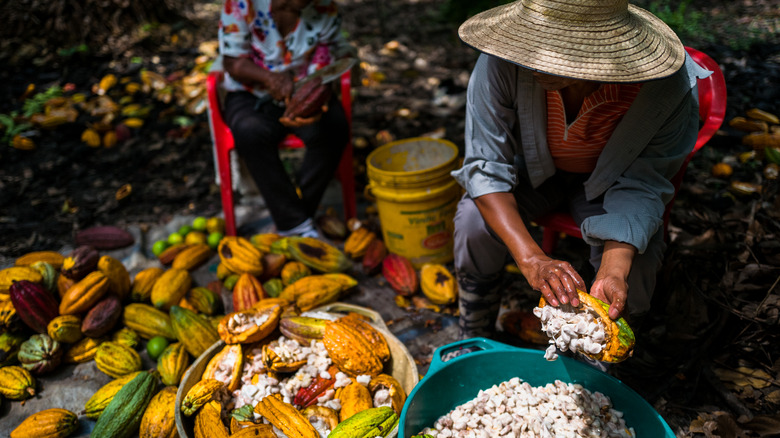Why You Should Be Skeptical Of Grand Cru Chocolate
We may receive a commission on purchases made from links.
Whether it's chocolate chips, bars, truffles, bonbons, or hot chocolate, cocoa is kind of an all-around crowd-pleaser. Everyone has their favorites, be they comforting desserts or desk snacks, and chocolate has certainly earned its place in our collective psyche as a delicious and decadent sweet treat. As the marketing manager for Asheville, North Carolina-based French Broad Chocolate, I have a unique insight into the many varieties of chocolate.
When shopping for and perusing the aisles at the grocery store — namely, the aisles specializing in chocolate — the average shopper is likely to see all manner of claims. Terms like "all-natural," "sustainably sourced," "Certified B Corp," "bird-friendly," and "Grand Cru" are stamped across chocolate products with abandon, and the uninitiated may weigh all of these claims as equally important. Some are more real than others, though, and the term "Grand Cru," though seemingly familiar and a marker of prestige on a bottle of wine, doesn't mean the same thing on a bar of chocolate. In fact, it doesn't really mean anything at all, if you talk to craft chocolatiers and chocolate-makers.
The meaning behind the term Grand Cru in chocolate
In regard to chocolate, Grand Cru defines a bar that's produced from cacao beans that hail from a specific region. This growing location should impart a distinct terroir to the chocolate, much like a grape's region informs the flavor of wine. Single origin chocolate is often sought after, since the beans are all grown in one spot, highlighting local flavors. For example, bars made from Indian cacao that grow next to mango plantations or nutmeg farms can take on some of those characteristics. It works with the same definition that a winemaker would use to describe an excellent vintage.
However, there is no certification for Grand Cru chocolate. Chocolate makers, cacao farmers, and chocolatiers don't have to pass any vigorous testing and aren't required to have any certification in order to use the term Grand Cru on their products. In that sense, it's the same as saying something is all natural; it doesn't mean much of anything.
So, why use the term?
If you read anything about Grand Cru it sounds pretty great, right? After all, it seems to be claiming that it's using the best cacao, from the best farms, for the best resulting chocolate. Sign us up! But the sad truth is that saying a chocolate bar is "grand cru" is just marketing jargon, pushing something as the best when there's no real certification or "rules" to make it so.
When something is labeled organic, the product has had to go through rigorous testing and inspections in order to earn the certifications proving it is so. Grand Cru is not the same — no testing or inspection is necessary. When applied to chocolate, it's understandable that the term could be confusing.
Grand Cru, in the wine world, requires certification and honors a producer, vineyard, or winery within a specific region. So, knowing that, it's understandable that someone seeing Grand Cru on a chocolate bar would assume the chocolate is of extremely high quality. That's not to say that any chocolate bar marked Grand Cru is bad. It's just not meaningful in the way that it would be on a beautiful bottle of French red.
Terms to look for instead
If you see "Grand Cru" scrolled across a chocolate bar, great. But what's better is seeing terms about the cacao beans themselves. "Single origin" is a term to look for, a title that explains that all of the cacao is from one spot. This means you're more likely to taste a defined flavor profile since terroir has a great bearing on cacao just as it does for wine.
When eating a single origin chocolate bar, you'll be able to tell that beans from Guatemala taste very different from beans hailing from India. Additionally, companies that create single origin bars are proud of the cacao sourcing, aiming to show it off its flavor characteristics. You won't find that with a commercial chocolate maker like Hershey's or Nestle, as those chocolate bars are a blend of cacao from many places, heavily masked with sugar, vanilla, and flavorings. Naturally, these single origin bars are more expensive chocolate products than your commercial options.
Another thing to look for is sustainable sourcing practices. You'll want to buy chocolate from companies looking to strengthen the overall supply chain of cacao. That means thoughtful business practices, including paying for better quality cacao and putting that money back into the farms from which they source. Many companies that do this are Certified B Corporations, businesses looking to use their capital as a force for good. There is rigorous testing and certification to obtain the B Corp stamp of approval. So, if you find Grand Cru chocolate, treat it as a doorway into looking for other certifications. It's not bad, but it doesn't mean much without other key terms backing it up.



